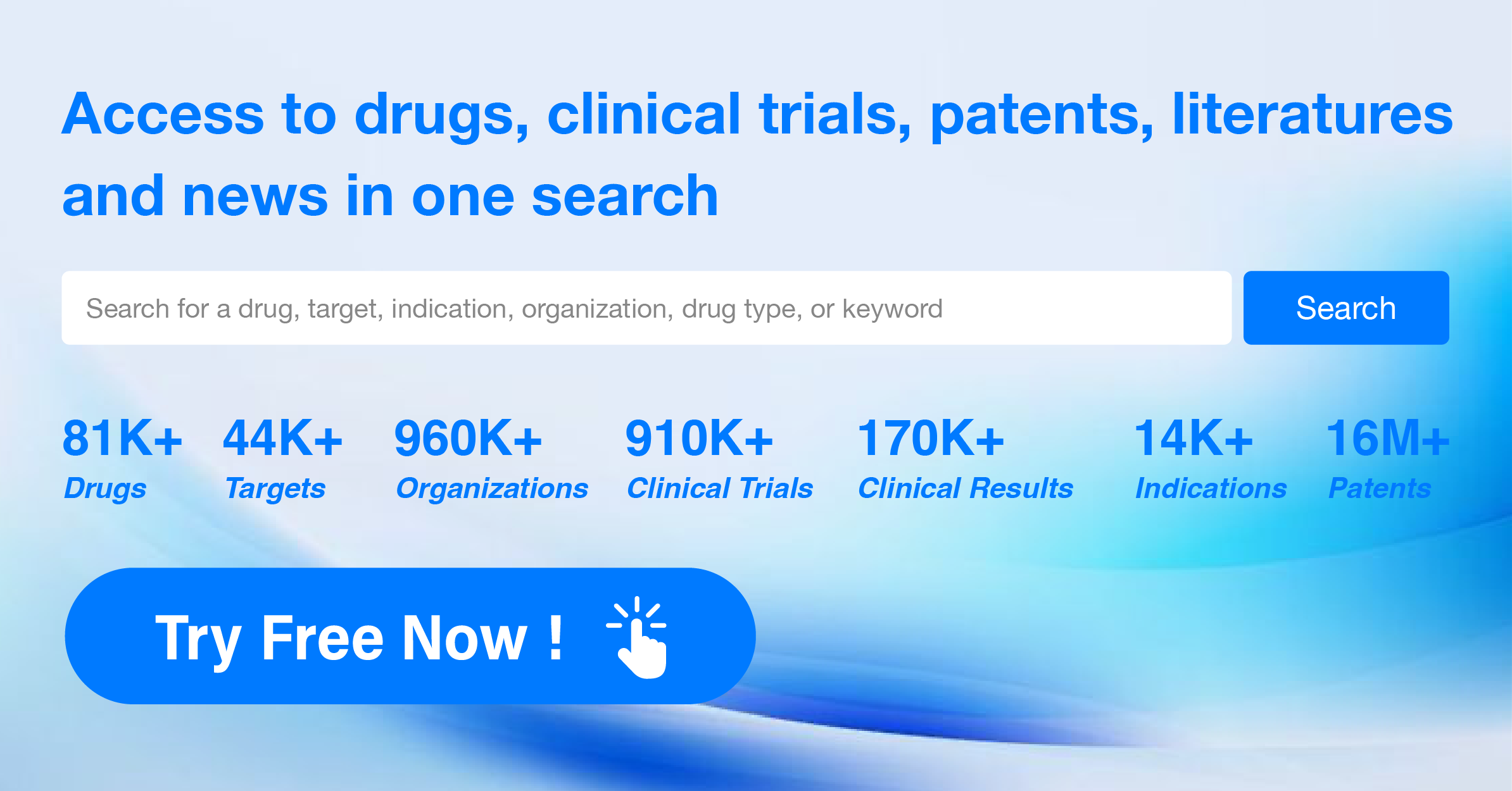Pharma Frontiers: Daily Digest of Global Pharmaceutical News - April 24
1.Pfizer/AbbVie's small molecule therapy Emblaveo approved for marketing
On April 23rd, Pfizer announced that the European Commission (EC) has approved the marketing of Emblaveo (aztreonam-avibactam), co-developed with AbbVie, for the treatment of adults with complicated intra-abdominal infections (cIAI), hospital-acquired pneumonia (HAP, including ventilator-associated pneumonia [VAP]), and complicated urinary tract infections (cUTI, including pyelonephritis). The drug is also indicated for the treatment of infections caused by aerobic Gram-negative bacteria in adult patients with limited treatment options. According to the press release, Emblaveo is the first β-lactam/β-lactamase inhibitor combination approved in the EU for the treatment of serious bacterial infections in adult patients caused by multidrug-resistant Gram-negative bacteria. Antimicrobial resistance (AMR) refers to the phenomenon where bacteria, viruses, fungi, and parasites mutate and develop resistance to antimicrobial drugs, which is considered one of the greatest threats to global health. As the spread of Gram-negative bacteria continues to increase, the development of new treatments for infections caused by Gram-negative bacteria has been designated a high priority by the World Health Organization (WHO). The approval of Emblaveo is primarily based on the results from previously reported Phase III studies comprised of the REVISIT and ASSEMBLE trials, designed to assess the efficacy, safety, and tolerability of Emblaveo in treating severe bacterial infections caused by Gram-negative bacteria (including MBL-producing multidrug-resistant pathogens, for which there are limited or no treatment options). The data supports the effectiveness of Emblaveo, with previously disclosed data showing a cure rate of 76.4% for patients with cIAI, compared to a 74.0% cure rate for patients treated with an active comparator. For HAP and VAP, the cure rates for Emblaveo and active comparators were 45.9% and 41.7%, respectively.
2.FDA approves combination of Altor super-agonist with BCG vaccine, achieving a 62% complete remission rate in cancer
On April 23rd, the U.S. FDA approved the use of Anktiva (nogapendekin alfa inbakicept), an Interleukin-15 (IL-15) superagonist developed by Altor BioScience, a subsidiary of ImmunityBio, in combination with Bacillus Calmette-Guérin (BCG) for the treatment of adult patients with non-muscle invasive bladder cancer (NMIBC) with carcinoma in situ (CIS) who are unresponsive to BCG, with or without papillary tumors. Bladder cancer is a common malignancy, with about 430,000 new diagnoses globally each year. Patients with NMIBC have cancer cells located in the bladder lining or have grown into the bladder cavity but have not yet spread to the muscle or other tissues. They account for 75% to 85% of all bladder cancer patients. BCG is the standard treatment for these patients; while effective, there is a high rate of recurrence and progression in patients treated with BCG. In such cases, the recommended treatment is radical cystectomy (bladder removal) to prevent cancer spread. The approval was principally based on the results of the QUILT-3.032 trial. This was a single-group, multi-center Phase 2/3 clinical trial. The primary endpoints of the trial were the achievement of a Complete Response (CR) at any time and the Duration of Response (DOR). CR was defined as a negative urinary cytology and cystoscopy (with biopsy under specific circumstances). The analysis showed that the CR rate for patients was 62% (95% CI: 51, 73). Moreover, 58% of patients who achieved CR had a DOR of ≥12 months, and 40% had a DOR of ≥24 months. The most common adverse reactions (≥15%) included abnormal laboratory findings such as elevated creatinine, dysuria, hematuria, urinary frequency, urgency, urinary tract infections, increased potassium, musculoskeletal pain, chills, and fever.
3.Sanofi's BTK Inhibitor Rilzabrutinib Phase III Clinical Study Hits Primary Endpoint
On April 23, Sanofi announced that its investigational BTK inhibitor Rilzabrutinib (SAR444671/PRN-1008) has achieved the primary endpoint in the Phase III LUNA 3 study for the treatment of adult patients with persistent or chronic immune thrombocytopenia (ITP). Sanofi plans to submit a marketing application for Rilzabrutinib to the FDA by the end of this year. Rilzabrutinib, an oral, reversible, covalent BTK inhibitor, was acquired by Sanofi through the purchase of Principia Biopharma. The LUNA 3 study aims to evaluate the efficacy and safety of Rilzabrutinib compared to placebo in adult and adolescent patients with persistent or chronic ITP who have previously received treatment. The double-blind treatment phase lasts 12–24 weeks, where patients receive either Rilzabrutinib (400 mg; twice daily) or placebo, followed by a 28-week open-label treatment and a 4-week safety follow-up period or long-term extension study. The primary endpoint of the study is the proportion of patients achieving a sustained platelet response (i.e., platelet counts ≥ 50,000/μL for at least 8 weeks during the last 12 weeks of the 24-week double-blind treatment period, without rescue therapy). Baseline platelet counts for patients were 15,000/μL (normal levels are 150,000–450,000/μL). The adult subgroup has been completed and results demonstrate that the primary endpoint was met with a significantly higher proportion of patients in the Rilzabrutinib group achieving a sustained platelet response compared to the placebo group, showing clinical and statistical significance. In terms of safety, Rilzabrutinib’s profile is consistent with previous studies. Detailed results will be presented at subsequent medical conferences. The adolescent subgroup trial is still ongoing, and participants are being recruited. Beyond the ITP indication, Sanofi is also exploring the therapeutic potential of Rilzabrutinib in other immune-driven conditions, including chronic spontaneous urticaria, IgG4-related diseases, and more.
4.Chia Tai Tianqing Pharmaceutical and Innovent Biologics' oncology combination therapy published in The Lancet journal's subsidiary
On April 23, Chia Tai Tianqing Pharmaceutical announced that the Lancet's sub-journal eClinicalMedicine published the results of a single-arm Phase 2 clinical study of the anti-cancer combination therapy of sintilimab in conjunction with anlotinib for the treatment of extensive-stage small cell lung cancer (SCLC) as a second-line or later therapy. The study indicated that the treatment regimen extended the median progression-free survival (mPFS) of patients with extensive-stage SCLC from 2-3 months, which is typical with traditional second-line therapies, to 6.1 months. Anlotinib, a novel small molecule multi-targeted tyrosine kinase inhibitor developed by Chia Tai Tianqing, has been approved in China for various indications including advanced non-small cell lung cancer, soft tissue sarcoma, small cell lung cancer, medullary thyroid carcinoma, and radioiodine-refractory differentiated thyroid cancer. Sintilimab, a anti-PD-1 monoclonal antibody co-developed by Innovent Biologics and Eli Lilly and Company, has been approved for seven indications in China. Recently, platinum-based chemotherapy in combination with immunotherapy has made significant progress as a first-line treatment for small cell lung cancer, improving the median overall survival of patients. However, choices for second-line and subsequent therapies for SCLC after first-line treatments are extremely limited, with only a few drugs approved, which are far from meeting the clinical needs. With the rise of immunotherapy, combination immunotherapy has become a focus of innovative treatment exploration for various cancers, including SCLC. The study results published in eClinicalMedicine indicate that the median PFS for the combined treatment of sintilimab with anlotinib for second-line or later therapy of extensive-stage SCLC reached 6.1 months. The PFS rates at 6 and 12 months were 54.1% and 31.7%, respectively; the median overall survival (OS) was 12.7 months, with OS rates at 12 and 18 months of 55.4% and 39.4%, respectively. In terms of efficacy evaluation, 4 patients achieved complete remission, 17 patients partial remission, and the objective response rate (ORR) and disease control rate (DCR) reached 56.8% and 89.2%, respectively.
5.Akeso Biopharma Announces Latest Anti-Tumor Data for PD-1/VEGF Bispecific Antibody
On April 23, Akeso Biopharma announced the publication of Phase 1a trial data for its self-developed PD-1/VEGF bispecific antibody drug, Ivonescimab (AK112/SMT112), in the Journal for ImmunoTherapy of Cancer (JITC), the official journal of the American Society of Cancer Immunotherapy. Akeso Biopharma's press release indicated that this study supports Akeso Biopharma's comprehensive scientific development strategy for Ivonescimab. Ivonescimab is a PD-1/VEGF bispecific antibody drug developed by Akeso Biopharma, designed to block the binding of PD-1 with PD-L1 and PD-L2, and simultaneously block the interaction of VEGF with its receptors. Combination therapies involving PD-1 antibodies and VEGF inhibitors have demonstrated strong efficacy in several types of tumors, including non-small cell lung cancer, renal cell carcinoma, and hepatocellular carcinoma. Given the co-expression of VEGF and PD-1 in the tumor microenvironment, Ivonescimab, as a single agent targeting both PD-1 and VEGF, may more effectively disrupt these pathways compared to combination therapies, thereby enhancing anti-tumor activity. The data published in JITC are from a Phase 1a trial that included 51 patients with advanced solid tumors, the majority of whom had undergone multiple lines of therapy, with 62.7% having received ≥3 lines of therapy, 35.3% having received anti-angiogenic treatment, and 29.4% having received immune checkpoint inhibitor therapy. The published data represent the results of the Phase 1a trial as of June 7, 2022, with a median follow-up of 12.8 months. The study results indicated that, despite most of the included tumor types being historically considered non-responsive to monotherapy immunotherapy (such as serous ovarian cancer, MSS colorectal cancer, and other cancers), Ivonescimab still demonstrated preliminary efficacy in these solid tumors, with an objective response rate (ORR) of 25.5%, and a disease control rate (DCR) of 63.8%.
6.Zhongmeihuadong Pharmaceutical's oral, long-acting, dual-target weight loss drug HDM1005 injectable solution is approved for clinical trials in the United States
On April 22, Huadong Medicine, a wholly-owned subsidiary of Zhongmeihuadong, announced that its injectable drug HDM1005 had been approved by the U.S. FDA for Phase I clinical trials, with the indication of weight management for adults who are overweight or obese. HDM1005 is a long-acting dual-target agonist peptide candidate targeting both the glucagon-like peptide-1 (GLP-1) receptor and the glucose-dependent insulinotropic peptide (GIP) receptor. GLP-1 is considered a strong therapeutic target for the treatment of obesity and type 2 diabetes, with this class of products having multiple effects, including weight reduction, blood sugar lowering, and cardiovascular benefits. GIP is a peptide hormone secreted by intestinal K cells, promoting insulin secretion to maintain glucose balance and facilitating the breakdown and deposition of white adipose tissue, complementing the effects of GLP-1 receptor agonists. Preclinical studies have shown that HDM1005, by activating both GLP-1 and GIP receptors, can promote insulin release, suppress appetite, and demonstrate significant improvements in glucose tolerance, blood sugar reduction, and weight loss. Furthermore, the current data demonstrate the candidate's favorable drug-like properties and safety profile. HDM1005 has also been approved for clinical trials in China, and is being developed for the treatment of type 2 diabetes and weight management in overweight or obese populations. In March 2024, the Phase 1a clinical study of HDM1005 in healthy volunteers completed the enrollment and dosing of the first participant. According to a press release from Huadong Medicine, the company has built a comprehensive and differentiated product pipeline focused on the GLP-1 target, including oral and injectable formulations of long-acting and multi-target innovative drugs as well as biosimilars.
7.Avistone Biotechnology's MET Inhibitor Buparlisib Approved for Treatment of Glioblastoma
On April 23rd, the official website of the National Medical Products Administration (NMPA) of China publicly announced the approval of the new indication for the marketing application of Vebreltinib (Buparlisib) enteric-coated capsules, submitted by Purunao Biotechnology, a wholly-owned subsidiary of Avistone Biotechnology. As per the priority review announcement made by the Center for Drug Evaluation (CDE) of China's NMPA, the newly approved indication for this drug is for the treatment of adults with IDH mutant grade IV astrocytoma or glioblastoma multiforme (GBM) with a history of lower-grade tumors that are recurrent or intolerant after radiation therapy and temozolomide (TMZ) treatment, and which have the PTPRZ1-MET (ZM) fusion gene. Glioblastomas initiate in the glial or progenitor cells within the Central Nervous System (CNS). The PTPRZ1-MET (ZM) fusion gene is a critical driver of the malignant progression in glioblastoma multiforme. After fusion of PTPRZ1 and MET genes, the MET loses the region of exons 1-2, leading to structural changes in the extracellular domain, enhanced sensitivity to ligands or autophosphorylation, and excessive phosphorylation of the MET segment in the fusion gene, which can activate downstream oncogenic signaling pathways such as STAT3, consequently increasing the tumor's proliferative and migratory capacity. Standard treatment for glioblastoma focuses mainly on surgical removal combined with adjuvant therapies such as radiotherapy and chemotherapy. Currently, no standard treatment exists for patients with recurrent glioblastoma multiforme, particularly those with ZM fusion gene-positive glioblastoma post-failure of standard treatments. Buparlisib enteric-coated capsules are a highly selective oral small molecule inhibitor of the mesenchymal-epithelial transition factor (MET), which can easily cross the blood-brain barrier, block the downstream signaling pathways of the ZM fusion gene, and inhibit tumor growth and invasion.
8.BMS Expands CAR-T Production Collaboration with $380 Million Investment
On April 22nd, BMS and Cellares, the world's first Integrated Development and Manufacturing Organization (IDMO) dedicated to the production of cell therapies at clinical and industrial scales, jointly announced a global capacity reservation and supply agreement for the production of CAR T cell therapies. The transaction is valued at up to $380 million, including upfront and milestone payments. As part of the agreement, Cellares will optimize and automate the production of certain BMS's CAR T cell therapies and transfer the technology to its automated high-throughput production platform, Cell Shuttle™. Cellares will provide multiple Cell Shuttle and Cell Q™ systems, which feature fully automated, high-throughput quality control capabilities, for the exclusive use of BMS. The Cell Shuttles and Cell Qs will be deployed in Cellares' smart factories located in the US, EU, and Japan. The production of cell therapies is complex, both operationally and technically. As cell therapies are rapidly changing the treatment landscape for many different diseases, the demand for such therapies is also significantly increasing. This collaboration allows BMS to expand its production capacity to meet the growing demand for its variety of cell therapies through a scalable platform, potentially reducing turnaround times and bringing the hope of cell therapy to more patients more quickly.
9.Treatment of Alzheimer's Disease: Leqembi Development Team Collaborates Once Again
On April 22nd, BioArctic announced a research evaluation agreement with Eisai for their investigative project BAN2802. BAN2802 is a potential new therapy for Alzheimer’s Disease (AD) that combines BioArctic's proprietary Blood-Brain Barrier (BBB) crossing technology with an undisclosed AD candidate drug. Upon conclusion of the collaboration, Eisai will evaluate the relevant data and decide whether to exercise its option to license the development of BAN2802 for the treatment of AD. The collaboration between BioArctic and Eisai dates back to 2005 when the two parties started working together in the development and commercialization of AD treatment drugs. This collaboration led to the birth of Leqembi (lecanemab), the first drug to be fully approved by the US FDA for the treatment of AD in 20 years, capable of slowing the progression of early-stage Alzheimer's Disease. The new collaboration will build on the joint knowledge of the two companies in the field of AD to evaluate a project that could potentially become the next generation of improved AD therapies. The cost of this study evaluation plan will be shared by both parties. According to BioArctic's official website, in addition to Leqembi, the company’s portfolio for AD includes five new antibodies with different mechanisms of action that hold promise for slowing or halting disease progression, all of which are currently in the preclinical research phase. For example, the AD1503 project is an antibody project targeting shorter, truncated forms of amyloid-beta protein that emerge early in the disease, exhibiting notable aggregation and the ability to form harmful types, potentially leading to Alzheimer's Disease. Other projects like BT2802 and BT2803 leverage the company’s BrainTransporter technology to develop new antibodies for AD treatment that harness its BBB crossing capabilities.




